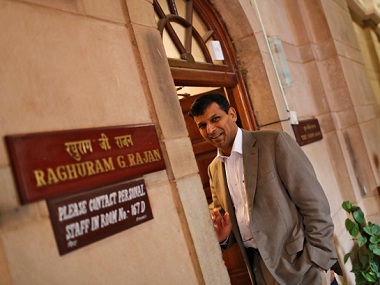There were no surprises in Raghuram Rajan’s last monetary policy announcement at the Reserve Bank of India (RBI) on Tuesday. The key lending rate of the RBI, repo rate, was retained at 6.5 percent — a move well understood given the RBI’s concern on the upside risks to consumer inflation. Secondly, liquidity is currently plenty in the banking system, thus not necessitating an urgent dose of rate cut. The market was hoping that if all goes well, a rate cut can come by October. But, given the persisting upside inflation and the apex bank’s March 2017 target of 5 percent, one needs to wait and watch if it goes for a rate cut then or wait further. The 7th Pay Commission pay out too could swell inflation. Though GST (goods and services Tax) roll out too is inflationary, it is too early to worry on that since we don’t even know what’s the rate going to be and 55 percent of the CPI basket wouldn’t get impacted with GST. But, these are clearly headaches awaiting Rajan’s successor. [caption id=“attachment_2769976” align=“alignleft” width=“380”]  RBI Governer Raghuram Rajan. File photo. Reuters[/caption] The RBI has targeted to bring down inflation to 5 percent by early next year and further to 4 percent. Note that in the policy, Rajan has cautioned on the upside risk on inflation, especially on the pulses and cereals. No victory on inflation yet Rajan is exiting the RBI at the end of his three–year term with no decisive victory on war on consumer inflation yet. That’s a fight the former IMF chief economist started on 4 September 2013 when he moved to the Mint Road from the North Block. At the last reading (June), the consumer price index (CPI) inflation, the primary focus of Indian central bank, was at 5.77 percent, very close to the upper band of 6 percent (on the lower side it is 2 percent). Prices of food and pulses continue to be on the higher side hurting households. At the best one can say this is a work in progress, but not a decisive victory yet. Although a good monsoon is generally expected to bring down food prices in the coming months, at this stage, food inflation continues to be a major threat hurting the common man. The CPI has been rising from 4.83 percent in March and 5.47 percent in April. The current trend indicates that food and vegetable inflation continue to be the major pain area of inflation. Food inflation rose to 7.79 percent in June from 7.47 percent in May while that of veg inflation rose to 14.74 percent from 10.85 percent. Going ahead, the food part of the inflation will remain key to decide the future course of inflation. Food constitutes almost 40 percent of the CPI basket. The spike in food and vegetable prices in recent months has caused almost 150 bps spike in the retail inflation, economists estimate. But, if monsoon continues to be good, most economists expect that prices of vegetables and pulses to come down in the approaching months, helping to lower inflation. It was under Rajan, the central bank began focusing on the retail inflation-focused policy based on the recommendations of the Urjit Patel panel. Until then, the WPI was the key inflation indicator. During Rajan’s tenure, the CPI inflation has been brought down to below 6 percent levels from near double-digit levels. But, a good part of the credit for that should also go to the crash in commodity and crude oil prices. It wasn’t a Rajan miracle alone. Government’s job But the more important point here is that the RBI has very limited role in controlling a supply-driven inflation. It is the government’s job to address the problems faced by farmers and take measures to ramp up production and improve pan-India food distribution. Interest rates can only influence demand. The RBI has cut the repo rate by 150 bps since January 2015 to fight inflation. “Till the time supply issues are not addressed, it is difficult to say the war on inflation is won,” said a leading economist with a global research institution. “The RBI has done whatever possible it could do to fight inflation,” said the economist. The good aspect is that finally the RBI and the Narendra Modi government are operating in sync to fight inflation. Last week, the government has obliged to the 4 percent (2 percent plus or minus) target until 2021 set by the RBI showed the central bank has support from the government on inflation-targeting. This shift in policy-focus has been welcomed by international rating agencies such as Moody’s. This is important since under the proposed MPC mechanism, the panel will henceforth determine the inflation target for the RBI. Beyond the inflation fight, Rajan has also spearheaded the banking sector reforms, including the bad loan clean-up, but much will depend on Rajan’s successor at the RBI. The encouraging part is that the foundation structure for future reforms in the banking sector has already been prepared. Rajan’s successor also has the task to prod banks to improve transmission of the RBI policy cues to the bank lending rates. This task is easier now after banks shifted to the marginal cost-based calculation to decide their base rates, or minimum lending rates, from average costs. Rajan is leaving the central bank with clear success on most of the tasks he accepted — a stable currency regime, laying foundation for the banking sector structural reforms and monetary policy reforms and quelling short-term concerns such as upcoming FCNRB redemptions. But, his big fight — inflation — remains to be fought. Here, the central bank has limited weapons in its arsenal. The government has a bigger role in this act.
In the big battle to tame inflation, the central bank has limited weapons in its arsenal. The government has a bigger role to play
Advertisement
End of Article


)

)
)
)
)
)
)
)
)



